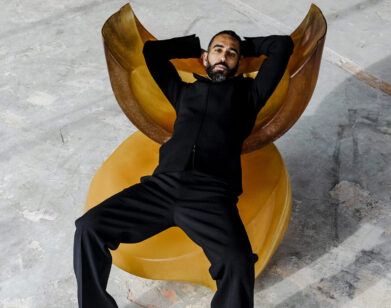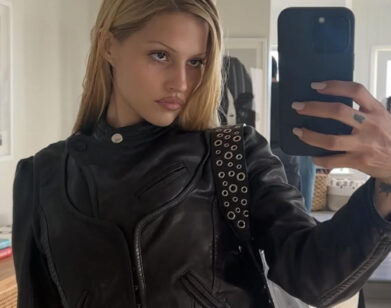Nowhere to Hide: Todd Cole Films Rodarte

STILL BY TODD COLE. COURTESY THE ARTIST AND RODARTE.
While fashion insiders run towards Rodarte’s designs, model Guinevere van Seenus wears them to run away from an omnious futuristic threat in “Aanteni,” photographer Todd Cole’s arresting short film that recently premiered on Nowness.com. Here we discuss the everyday fears and dark visions inspiring his collaboration with the Mulleavys sisters.
ANA FINEL HONIGMAN: What inspired the film?
TODD COLE: Kate, Laura and I wanted make a horror film. There is something incredibly beautiful in the distressed qualities of the Spring 2010 Collection—the burning, the shredding, the aged textures. I started with this vision of a woman running scared through the abandoned streets of sunny Los Angeles, as if she had escaped from a dark place wearing beautiful, distressed shards of clothing. T then the question was, what was she running from?
HONIGMAN: There seem to be lots of more worldly things to run from in LA.
COLE: We didn’t want to make a slasher film, which could easily go south and become super corny.
HONIGMAN: What frightens you?
COLE: One thing we are all uneasy about is technology. Is this cell phone going to give me brain cancer? Will all the chemicals and additives in our food produce mutations through chromosome damage?
HONIGMAN: How do these fears relate to the imagery in the film?
COLE: Technology became the villain, as represented by the rocket engines. I found that footage to be particularly violent, and I placed it in the film in a way that was hopefully emotionally suggestive and a unnerving.
HONIGMAN: Do think there is credence to the theory that Kubrick directed the footage of the moon landing?
COLE: I love the idea of Kubrick being blackmailed so that he had to fake the Lunar landings. But I do think we landed on the moon. And I think it is very possible that there are ancient structures on the moon, and I do believe that the face on Mars is real, and that area of Cydonia is an ancient city laid out with an advanced geometry.
HONIGMAN: Rodarte’s emphasis on craft seems incongruous with a futuristic theme. How does their aesthetic fit with your vision of the future?
COLE: To me, Rodarte’s designs have a very primal feel, and the energy that that these rockets release is incredibly primal, which I thought mirrored the quality of the dresses. The rockets and the dresses are both futuristic and primal at the same time. When I met with the girls to discuss the project, we realized we were referencing the same things. One of our favorite books is Sex and Rockets, which is the story of Jack Parsons, one of the founders of Jet Propulsion Laboratories in Pasadena. He was a brilliant, self-taught chemist and a devoted follower of the dark magic of Aleister Crowley. He designed rockets by day, and at night was performing Crowley rituals; stuff like conjuring the Whore of Babylon. He died in a mysterious lab explosion in 1952. So I am bit fascinated with the rumored connection between the occult and the space program, and I think this found its way into the film as well.
HONIGMAN: Why did you select Guinevere van Seenus as the protagonist?
COLE: She was the only one who could pull it off. Guinevere has an otherworldly beauty, and an oddness that fit perfectly with the mood. She needed to act and I found her to be incredibly talented as an actress. I couldn’t believe how she would focus and get into a character so perfectly, from the first take. And though she was nervous about acting, I found her to be completely fearless once we started rolling. What Guinevere had to do in the film was much more difficult than what is typically required for a still shoot. With film, there is nothing to hide behind. There are 24 frames per second… and no retouching, which requires tremendous courage on the model’s part.
HONIGMAN: Are you ultimately optimistic or frightened for the future?
COLE: I think human beings have incredible potential and are capable of so much good. Maybe things have gotten bad enough that we might change direction.






